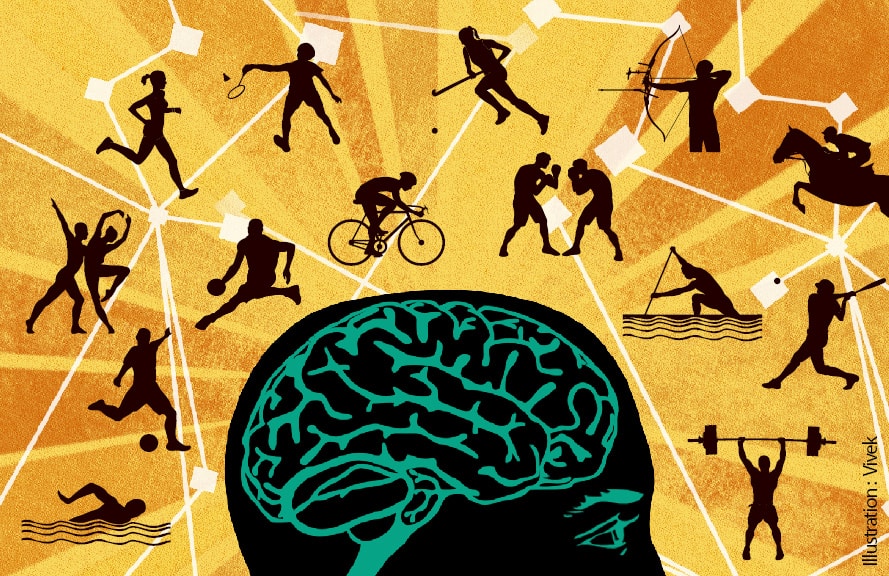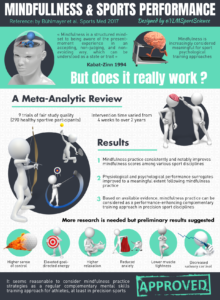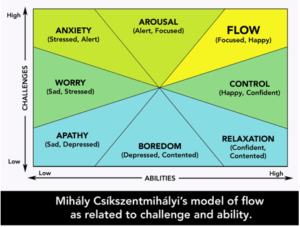
It is challenging to stay mindful of today’s constant interruption and information overload. It is hard to block the thoughts, especially the negative ones, while constantly being bombarded with news and going through everyday problems. Regardless of occupation, age, sex, or race, everyone would benefit from the ability or skill to stay in the present moment while observing the thoughts and emotions come and go. So, if you ask yourself what mindfulness is, here is a definition (one of many out there):
Mindfulness is the awareness that emerges through paying attention to purpose, in the present moment, and nonjudgmentally to the unfolding of experience moment by moment. (Kabat-Zinn, 2003, p.145)
There are myriad benefits associated with mindfulness practice. For example, research suggests it promotes well-being by promoting good emotions, improves focus and ability to stay on task or improves your social interactions (which translates to your relationships), positively affects emotional regulation, provides an opportunity for bouncing back after a setback, etc.
The benefits of mindful practice are not limited to everyday life and only to ordinary or mundane people (I don’t mean to offend anyone). Still, they can also relate to an athlete’s performance, which is the main focus of this post.
Mindfulness practice and sports performance
For successful sports performance, it is not enough to think only about the physical aspect of the preparation. For a while, it has been known that mental status plays a huge role in how athletes behave, affecting their performance. Therefore, besides planning how to make an athlete faster, stronger, and more significant, a big chunk of athletes’ training routines is mental preparation.
As part of the mental preparation, coaches use various techniques and approaches to help their athletes to get a pick mental state so they can perform at their best. Some strategies and techniques involve breathing techniques, autogenic training, progressive muscular relaxation, mindfulness, and visualization. Lately, the impact of mindfulness practice on our lives and sports performance has been of particular interest.
Being mindful is about tolerance and acceptance (nonjudgmental) towards feelings, thoughts, and emotions. This could help athletes stay present and focused on the current task (Goodman, Kashdan, Mallarad, & Schumann, 2014).

The Inner Voice
How often have you been consumed with thoughts and emotions after getting the bracket and have seen that you are in a group with someone you do not want to be with? Of course, the first thought is, “ Damn it,” “Bad luck,” or “No luck at all.” Followed by anxiety.
Now comes when you start doubting your qualities and overthinking about your opponent instead of focusing on yourself and what is in your control. If you’ve ever heard about Stoics and their philosophy, you would know that beating up and eating yourself alive about something that is not in your control is the number one mistake you what to avoid. Negative experience that somehow challenges athletes’ skills, confidence, and ability to perform result in athletes drowning in negative or counterproductive self-talk.
GOOD LUCK COMING BACK FROM THAT!
Negative Self-Talk
The process of self-talk is governed by the narrative part of the brain that appears automatically and might not be evident at first glance. At this point, an athlete can only get back into the game by shifting from narrative into the direct experience mode – being mindful (Sam Boys, 2019).
For this reason, the athlete must get familiar with strategies that can help them manage and, in some way, direct the “inner voice” in the desired direction to experience increased performance, satisfaction, and enjoyment. This is possible only by learning how to keep attention in the present moment.
And by now, you probably know the answer … one of the most potent brain-enhancing drugs is a mindfulness practice.
The Power of Mindfulness
Practicing mindfulness has been shown to have a positive impact on the overall well-being as well as sports performance (Baltzell, 2016, Pinean, Glass & Kaufman, 2014).
This is accomplished through becoming more aware of the emotions we are experiencing every day, on the court or the tatami, and the triggers responsible for the sensations. (getting in groups with athletes you want to avoid, or finding out that there have been changes in the schedule and the organizer is using brand new tatami that might be slippery) – tell me you haven’t thought about this at least once?
Implementing mindfulness techniques can help athletes become more aware of the present moment without getting trapped in an overthinking loop (narrative mode) related to the competition outcome/organization/past mistakes and other variables they do not have control over, such as referees, weather, opponents, etc.
By engaging in a non-judgmental awareness (being mindful), an athlete will become aware of his experiences with different stimuli, as well as the types of distractions (physical, mental, emotional, and social) he might be subjected to during or before his performance.
By being aware of the present moment, an athlete will be able to increase the capacity for concentration which will positively influence how the athlete deals with distractions. Therefore, he will identify a setup of any negative self-talk and act timely.
HOW TO PRACTICE MINDFULNESS AND WHERE TO START FROM
FIRST OF ALL, no trip to Nepal or a sacred temple is needed. No weird clothes or mantras that you need to repeat three times a day. It would help if you started a simple practice where you draw your attention inwards to yourself (focusing on body sensations or breath) or outwards (perceiving what is happening around you by looking or listening).
Introduce mindfulness practice at the beginning of your training
Take a moment to notice what is going on in and around you (you can do this practice at home, outside in nature, or your dojo)
-
Look around you. What do you see? Choose one thing and pay attention to the colors, shape, or how far away it is.
-
Close your eyes. Focus on one sound you can hear. Is it loud or subtle? Is it calming or irritating? Does it have rhythm?
-
Keep your eyes closed. Start feeling different body sensations. Do you feel the tension in any body part? Do you feel the ground under your feet? Hands. Legs. Or maybe feel the breath. Where do you feel it? In your belly or chest? Is it slow or fast?
You do not have to introduce all these steps at the same time. My favorite practice is mindful breathing, where I pay attention to my breath and try to stay with it while observing thoughts come and go. Sometimes I count to 10, recording every inhalation and exhalation. If I get lost in thought before coming to 10, I start again from 1. Try it!
This could be a great routine to implement at the beginning and end of your practice during MOKUSO time. This would allow you to remove all your problems, ideas, or things to play to do in the future or after your workout and focus solely on your practice.
Introduce mindfulness during your karate practice (staying in the moment)
After a few years of practice, it is easy to start performing different karate techniques mechanically without thinking much about the movement. It comes naturally. Which is a good thing. But what’s not good is that we also stop thinking about the feeling and sensations accompanying the movement. This is the moment when you stop being mindful.
We think about performing better, faster, and stronger than the opponent, consumed by the idea of winning. This subconsciously burdens us mentally, leading to anxiety, doubt, too much excitement, and overwhelming. All this strips us away from the opportunity to enjoy the moment. And when you are not in the moment, you are somewhere else. You get absorbed by your feelings, taught, and emotions that are not associated with the present. So become mindful of your practice!
During your karate practice, try introducing mindfulness practice as much as possible. For example, start by being aware of your breathing and inner voice before executing specific techniques, sparring with your partner, or performing a kata.
How to start being aware of your inner talk
-
Take a moment to acknowledge your internal dialogue;
-
What are you thinking and telling yourself when preparing for your belt exam of competition? (first, start practicing this on training)
-
What are you thinking: “I am not as fast as he is” or “the judges will be on his side”?
-
Is this helpful information? Do you have control over these things, and is this relevant to your performance?
-
Become aware of the inner dialogue and gradually eliminate it if it is counterproductive. Remember, mindfulness practice is non-judgmental.
-
The next thing you should do is to BRING YOUR AWARENESS TO THE PRESENT MOMENT. The best way to do that is by taking your attention to breathing. Remember, the great is your anchor, not letting you get lost in thoughts and negative inner dialogue.
Try becoming aware of your self-talk during practice.
Stay and be absorbed in the moment while performing a kata (this can be applied to kumite as well or any technical performance)
Practicing any kata is a perfect way to stay present. Especially ones you’ve moved to a stage where you don’t think of the upcoming element or the direction in which you need to move. People are more mindful when they start learning a kata. This is because you think only about the element coming instead of the previous one or the element two or three steps ahead.
Once you get comfortable with a particular kata, mainly if you compete, your mind might start wandering around, asking questions, or throwing doubt on specific techniques. Since the kata require less brainpower (you’ve already done the kata a hundred times), we open space for thought and inner talks, which can be non-productive.
What to do?
To avoid getting trapped in this loop, during your performance, bring your attention to the current sensations and feelings you have for a particular element:
-
Feel the ground under your feet;
-
Your hips, legs, core, arms, and neck;
-
Feel your breath; (are you breathing normally or holding your breath)
-
Is it comfortable or challenging in that particular stance?
-
Do you feel stable?
-
Do you feel the flow of energy throughout your body?
Please focus on the present moment and sensations, and accept them. Doing so has been shown to affect some physiological skills, such as the ability to relax. Consequently, this will reduce anxiety levels, sadness, and confusion, which are part of the athlete’s life (Keng, Smoski, & Robins, 2011; Peterson &Pbert, 1992).
Start using mindfulness during training time to be able to experience its benefits during competition.
While kata/kumite, focus on the element you are performing. Do not stress about the previous mistakes (at practice, if you make a mistake, do not stop to repeat the part. Instead, continue and learn to deal with that and focus on the present) or upcoming elements (maybe the jump in kata Unsu) until you get there. Stay present. Get in the zone.
Mindfulness = getting in the zone and effortless activity
Have you ever been in a situation where everything you do is effortless, perfectly synchronized, and in its place? A place where you have control over every movement. In sports, this is described as a state of flow or being in the zone.
“In positive psychology, flow, also known as the zone, is the mental state of operation in which a person performing an activity is fully immersed in a feeling of energized focus, full involvement, and enjoyment in the process of the activity. In essence, flow is characterized by complete absorption in what one does and loses a sense of space and time.” – Mihalyi Csikszentmihalyi

Many definitions describe the state of flow. However, it is essential to remember that it happens when athletes are focused on what they are doing, being aware of the feeling of the movement. Consequently, their enjoyment of a particular activity increases.
As mindfulness becomes a popular segment of sports psychology, it has been used extensively to help athletes achieve a state of flow or get in the zone. Although additional research and evidence are needed to understand how this can be adjusted for different sports, the benefits of mindfulness are clear. They should be included in the training process.
Remember, the most important thing is continuity. Every moment in your day and karate practice poses an opportunity for practicing mindfulness. You need to start and keep going.

